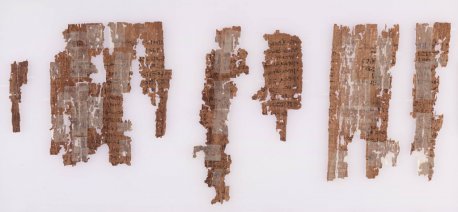Fragments of the Book of Thoth
Egyptosophy
Fragments of the Book of Thoth [ edit ]
Graeco-Roman religion equated the Egyptian god Thoth, patron of scribes and writing, with the Greek deity Hermes, messenger of the gods and guide of souls. As "thrice great"--a description originating in Egyptian epithets--Thoth-Hermes becomes Hermes Trismegistos. Hermeticism stressed the copying of ancient and "revealed" knowledge, related to Thoth/Hermes and Imhotep/Asclepius, primarily in a series of books known as the Corpus Hermeticum. Texts such as Kore Kosmou, "Pupil of the World," and the Poimandres reveal Egyptian views of the creation of the world. In the Middle Ages and the early Renaissance Hermes Trismegistos was believed to have been a human lawgiver, a pagan counterpart to Moses. In keeping with an Egyptian origin, a basic tenet of Hermeticism in that the mortal is mirror of the immortal, and the person is a miniature of the cosmos. As a summary of the Hermetica put it: "what is above is as what is below." This summary, the "Emerald Tablet" (Tabula Smaragdina), was said to have been found in the tomb of Hermes Trismegistos, but was probably written by an Arab alchemist. It later received a commentary by alchemist and physicist Isaac Newton. The recently identified demotic Egyptian "Book of Thoth", also in this section, may relate to the Hermetic corpus.
The demotic script on thepapyrus of the Book of Thoth is an abbreviated version of the earlier cursive hieratic script, and the fragments belong to a lengthier composition known as the Book of Thoth. Containing a dialogue between Thoth, the teacher (most commonly referred to by his epithets "He of Hesert" or "He who praises knowledge"), and a disciple called "he who loves learning." The dialogue format and discussion of scribal knowledge within the text parallels some aspects of the Greek Hermetic texts that had such an influence in medieval Arabic thought and the western Renaissance. The papyrus fragments here include a dialogue between Thoth and his disciple, which involves bulls, cows, agricultural tasks, and a mention of the "writings of the House of Darkness," probably a reference to the Underworld.
The other two images of Thoth given here are two small amulets with Thoth in two of his guises. One faience statuette shows the god Thoth as a baboon holding an udjat-eye (the right half of the eye is damaged). Such small images are ubiquitous in Late Period Egypt, and the small loop on the back of the baboon figure suggests that it was worn as an amulet. Wearing an amulet of Thoth was a method of gaining his protection, or of identifying the wearer with certain aspects of Thoth. The baboon avatar of Thoth holding a divine eye embodies an entire mythic cycle involving the sun god Re, Thoth, and the goddess of the eye of the sun. The lunar god Thoth, inventor of hieroglyphs and calendars and scribe of Re, is also charged with fetching the solar eye goddess from the south. According to an extensive demotic text and numerous earlier allusions, the "eye of Re," who can be named as Sakhmet, Hathor, or several other goddesses, rebels against her father and flees to the south. Thoth is sent to coax the goddess back to Egypt, and in the demotic text, he tells the goddess a series of stories, many of them involving animal characters. In the Yale figurine (as in many other examples), Thoth triumphantly holds the eye that he has successfully recovered, restoring the divine world and hence Egypt itself to proper order. Thoth's accomplished task may be read in ancient Egyptian as ini set "the one who fetched her," which is phonetically similar to the term niset, king, and in playful, cryptographic hieroglyphic inscriptions, the baboon holding the eye can actually write the noun "king."
The other amulet is made of glazed blue faience, and stands 3.1 cm by 1.0 cm. It depicts the god Thoth in ibis-headed anthropomorphic form, striding forward with the left foot, while the arms are held stiffly at the sides. Thoth wears no headdress, but sports an elaborate wig that falls over both shoulders. The figure stands on a small rectangular base. This object lacks provenance, but likely dates to the Twenty-Sixth Dynasty. A small hole in the back pillar allowed this object to be threaded onto a string and worn on the body.
Dimensions
H. 18.5 cm, W. 44cm
Material
Papyrus
Museum
Beinecke Rare Book Library
Accession Number
CtYBR Inv. 323
F. Ebeling, The Secret History of Hermes Trismegistus: Hermeticism from Ancient to Modern Times, trans. David Lorton (Ithaca, 2007).
E. Hornung, The Secret Lore of Egypt: Its Impact on the West, trans. David Lorton (Ithaca, 2001).
R. Jasnow and K.-T. Zauzich, Ancient Egyptian Book of Thoth: a Demotic discourse on knowledge and pendant to the classical Hermetica (Wiesabden, 2005).























